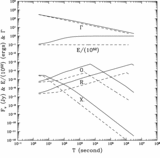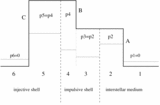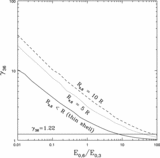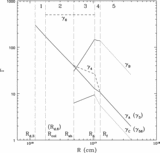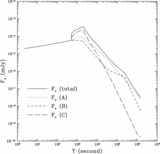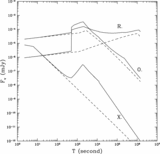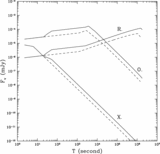Image Details

Caption: Fig. 1.
Injection light curves from a Poynting‐flux–dominated flow ejected by a highly magnetized millisecond pulsar (magnetar) central engine. Solid and dashed lines are the cases with or without a continuous energy injection. Shown are the bulk Lorentz factor of the blast wave, the total energy in the fireball, as well as the light curves in various bands (X‐ray: ﹩\nu =10^{18}﹩ Hz; optical: ﹩\nu =10^{14}﹩ Hz; radio: ﹩\nu =10^{10}﹩ Hz). Parameters adopted: ﹩E_{\mathrm{imp}\,}=10^{51}﹩ ergs, ﹩n=1\mathrm{cm}\,^{-3}﹩, ﹩\Gamma _{0}=300﹩, ﹩\epsilon _{e}=0.1﹩, ﹩\epsilon _{B}=0.01﹩, and ﹩p=2.5﹩. Different pulsar parameters lead to the injection being either "immediate" or "delayed." (a) Immediate injection: ﹩B_{p}=10^{16}﹩ G and ﹩P_{0}=1.5﹩ ms; (b) delayed injection: ﹩B_{p}=10^{14}﹩ G and ﹩P_{0}=1.5﹩ ms.
Copyright and Terms & Conditions
© 2002. The American Astronomical Society. All rights reserved. Printed in U.S.A.


